Updated 1 year ago
How the U.S. electrical grid works
Written by
Ben Zientara
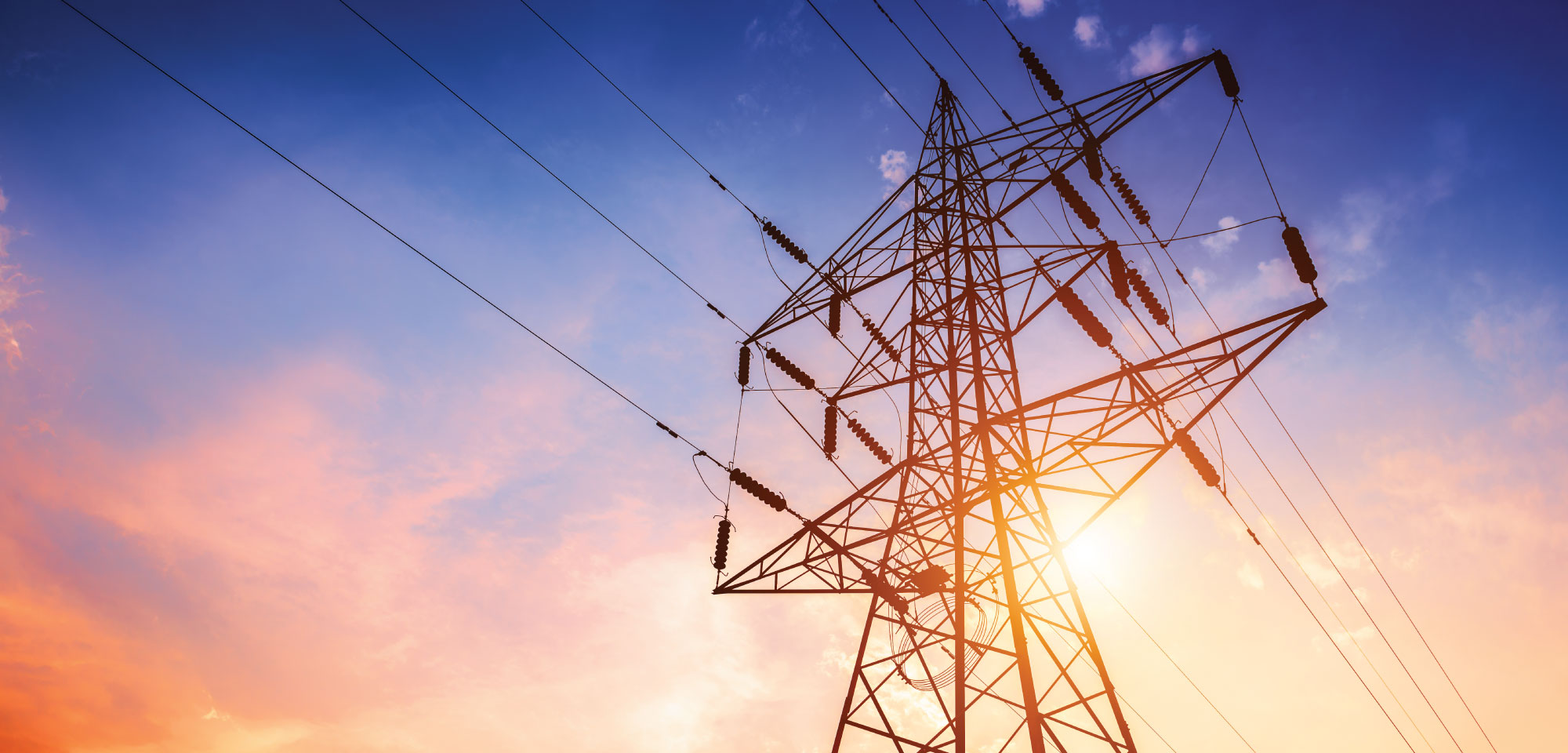
Find out what solar panels cost in your area
The United States electrical grid has been called the world’s largest and most complicated machine. It is a delicately balanced, interconnected web of power sources and users, more complex than anything a million spiders could weave. Every day, millions of people rely on this extremely complicated network to function flawlessly—and it does, and amazing 99.9% of the time.
The electrical grid works by perfectly matching the amount of power that is produced to the amount of power that is needed. Every minute of every day, the grid has to produce the exact amount of power that is needed and react within seconds if there is an imbalance.
When your air conditioner turns on, a generator somewhere spins just a little slower and has to be rebalanced to maintain voltage. This precise management of generation and usage (loads) happens instantaneously, but preparations for the amount of power that will be needed at any given time are first made across many time frames, from an hour ahead to years in advance.
This planning requires the participation of thousands of people, companies, industry organizations, and governmental entities. Below, we talk about all of the entities involved in running the grid, and how they contribute to keeping the world’s largest and most complicated machine running smoothly.
Key takeaways
-
The four main aspects of the electrical grid are generation, transmission, distribution, and consumption, with the first three making up what’s called “the supply chain”.
-
The fifth aspect of the grid is regulation, which keeps the grid safe, reliable, and secure.
-
Several national and regional entities are tasked with making the grid reliable, and a separate group of entities oversee wholesale energy markets and ensure the transmission grid is maintained.
-
The U.S. electrical grid is actually made up of three mostly-separate grids called the Eastern, Western, and Texas Interconnections, and the various oversight entities operate within these broad geographical boundaries.
-
The future of the electric grid will include more renewable generation and battery storage, and allow large groups of distributed resources like rooftop solar and small batteries to participate in providing energy and other services.
Components of the grid
There are four main components of an electric grid:
Generation
Transmission
Distribution
Consumption
Together, these four concepts cover how electricity is made, moved, and used. Then there’s a fifth, bonus part of the electric grid: regulation, which covers how the grid is developed and managed.
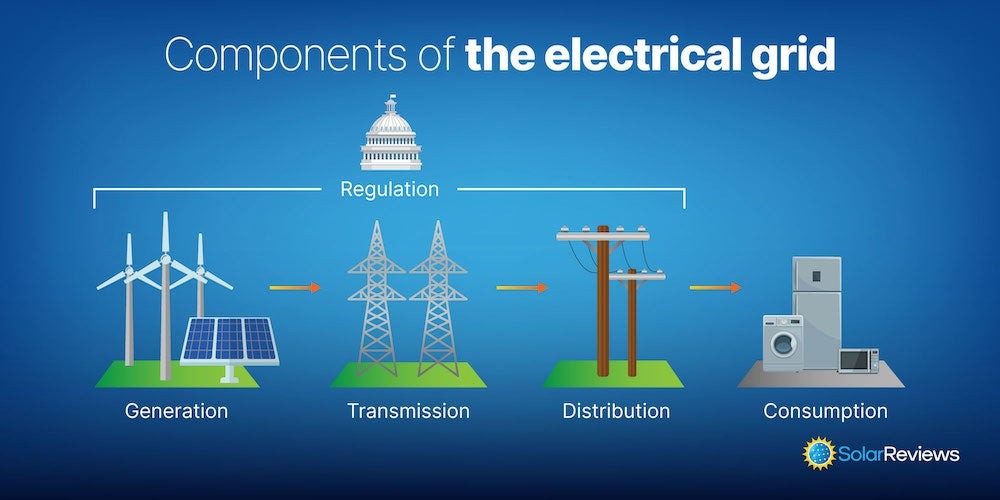
Here’s a little closer look at each one:
Generation
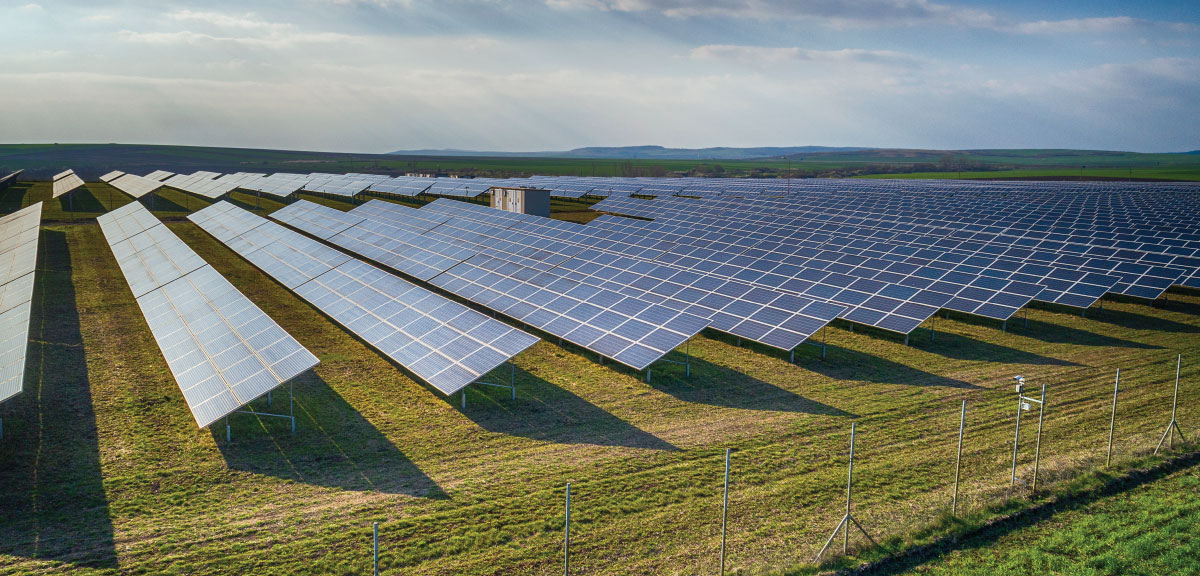
Large fields of solar panels serve as generation plants for the grid.
Generation refers to the sources of electrical power. In the early 1830s, Michael Faraday discovered that mechanical energy could be converted to electrical energy by rotating a conductive element inside a magnetic field. Within 50 years, that concept had been refined and applied at a large scale, with the mechanical energy supplied by huge turbines spun by steam from water boiled using burned coal or hydropower.
In 1882, the Edison Illuminating Company first activated its Pearl Street Station electrical generation plant, which burned coal to make steam that turned huge “dynamos,” aka generators. Though the plant initially served fewer than 100 lighting customers, it represented the first electrical grid.
Modern sources of electrical generation include turbines that use coal, gas, hydro, nuclear, wind, and geothermal heat as fuel sources. And then there’s our favorite source of electricity: photovoltaic power, which requires no mechanical energy or moving parts in its production. Instead, it generates an electrical current from excited electrons in semiconductor materials like silicon or thin film solar cells.
Here’s a graphic showing the sources of generation (greater than 1 megawatt) in the United States as of 2021:
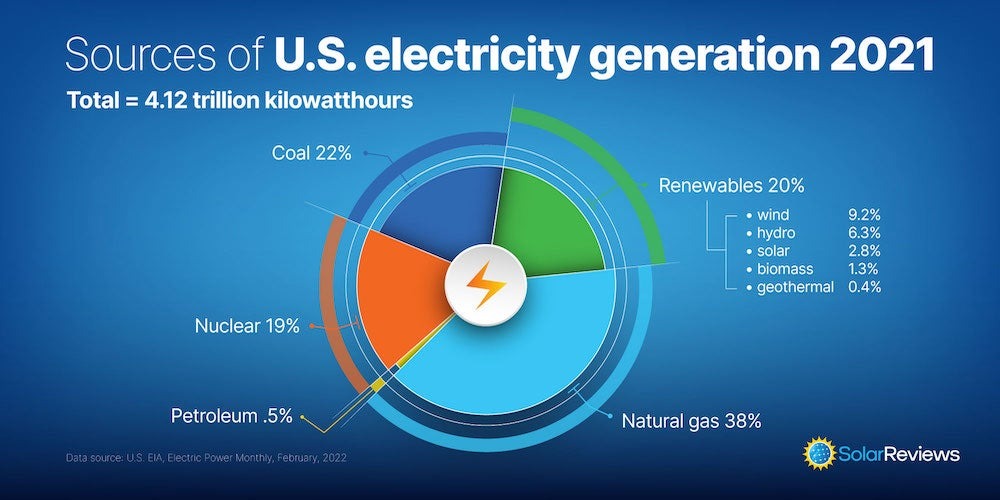
Types of power plants
When we refer to generation on the grid, we’re talking about large-scale installations that typically generate power measured in megawatts (MW). The largest generators in the world can produce power measured in gigawatts (GW), or thousands of megawatts.
The largest power plants produce what’s known as baseload power, meaning they are always running and the power they make is mostly all needed, all the time. Large nuclear, coal, hydroelectric, and even geothermal power plants produce baseload power. These plants take a long time to start up (from hours to days), producing reliable electricity cheaply once running.
As energy demands change throughout the day, peaking power plants are used to meet demand. These plants can start up quickly and provide power soon after they’re activated. They are sometimes referred to as “dispatchable generation,” because they respond to orders to increase power supply. Traditional peaking plants burn natural gas or biogas to turn steam turbines, but recently energy storage systems like grid-scale batteries or pumped hydro storage systems have been used to respond to peak demand.
Finally, renewable resources like solar and wind are known as intermittent generation. As some renewable-haters like to point out, the sun doesn’t always shine, and the wind doesn’t always blow. Thankfully, meteorologists can now predict the weather with near-perfect accuracy a day ahead of time, so grid operators can plan for intermittent generation based on predicted conditions and adjust the amount of power generated by other sources in response.
As grid-scale energy storage options increase, intermittent resources will be partly used to charge batteries. Large-scale energy storage will help to solve the problem of intermittency, acting like a hybrid of baseload and peaking power plants by supplying consistent power and standing ready to be activated in response to demand changes.
Transmission
Whether we’re discussing baseload, peakers, or renewables, nearly all large generation sources are located away from the customers their power serves. That’s where transmission lines come in.
The U.S. transmission system is made up of high-voltage power lines that carry electricity from where it’s generated to the areas where it is distributed for use.
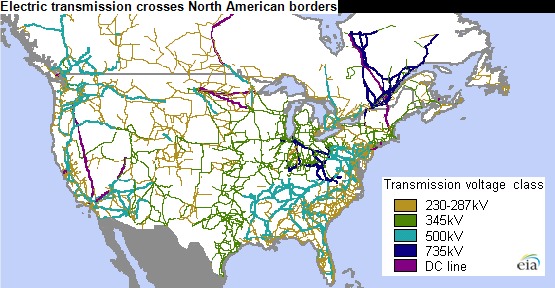
A map of U.S. transmission lines. Image source: EIA
In the U.S., most transmission occurs via overhead power lines suspended high in the air on transmission towers or pylons. You’ve probably seen them running across the landscape, looking like giant Tinkertoy towers.
These wires carry power at very high voltages to reduce losses. Most of the power that we use in homes and businesses is served at 120 or 240 volts, but transmission and subtransmission lines are designed to carry power at tens or hundreds of kilo volts (kV).
Here’s an image showing how to identify the voltage carried on the wires based on transmission tower design:
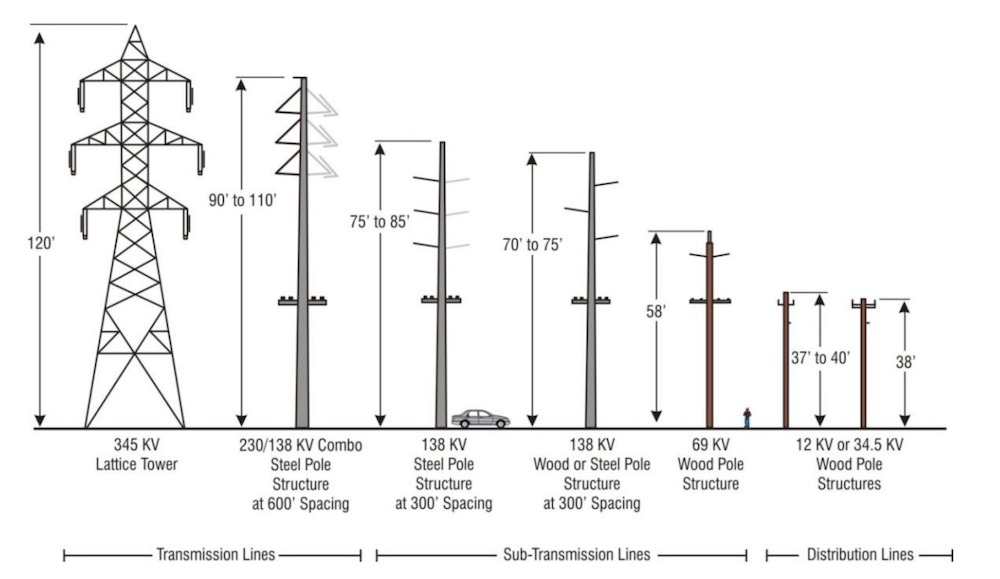
Transmission tower design can help identify line voltage. Image source: getintoenergy
The transmission system is designed to carry very high voltages, but the power generated by even the largest turbines doesn’t operate at these voltages. So as power is generated, it must be “stepped up” by transformers at a substation before transmission. Then the power is sent along the wires until it reaches a distribution substation, where it is stepped down again so it can be sent into neighborhoods.
Distribution
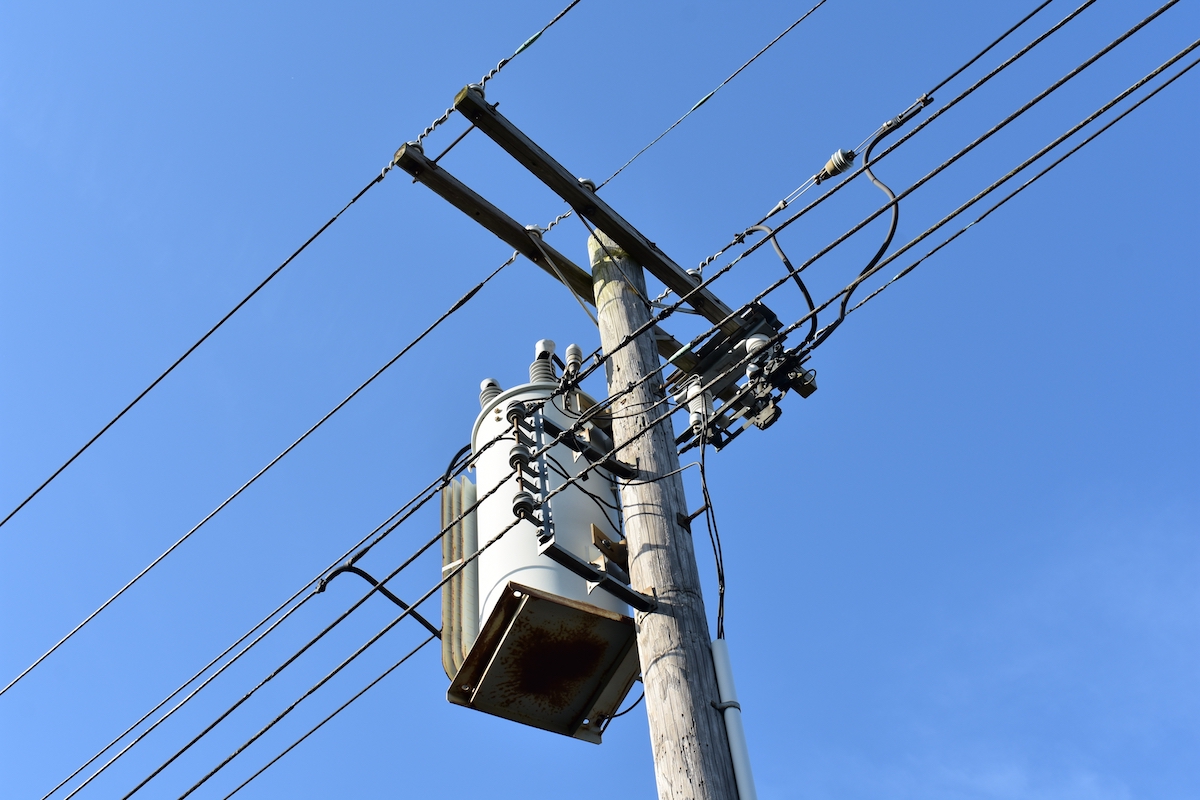
Distribution lines are the wires mounted on wood pole structures that run throughout cities and towns where electricity customers live. Smaller transformers are located either on poles or in ground-mounted transformer boxes near customers, depending on whether the wires are overhead or underground. These transformers step the power down one final time to the 240 volts used in most homes and businesses.
These distribution transformers are bi-directional, also stepping power up when it is sent to the grid from what is known as distributed energy resources (DERs). Solar installations, small wind turbines, batteries, and other devices fall under this category. When DERs make more power than is needed by their host customer (for example, a home with solar panels), it is sent back along the wires to the pole and then immediately served to other consumers in the local area.
DERs like these are also often referred to as “behind the meter.”
What it means to be “behind the meter”
“Behind the meter” (BTM) literally means a generation system installed on the customer side of the utility meter. These systems produce power that is primarily intended to be consumed on-site. A common type of behind-the-meter system is a rooftop solar array: the solar panels generate electricity that is then fed into the customer’s building(s) for use.
Excess generation from BTM systems can be sent back to the grid to be consumed by the customer’s neighbors. In this case, the utility meter records only power that passes from the grid to the customer or from the customer to the grid.
This is in contrast to “in front of the meter,” systems, which are the kinds of generation systems described above, which feed power directly into the distribution and transmission systems, and sell that power to grid operators at a negotiated price.
Behind-the-meter power generation is also known by several other names: distributed generation, local generation, and embedded generation. They all refer to the same thing.
Consumption
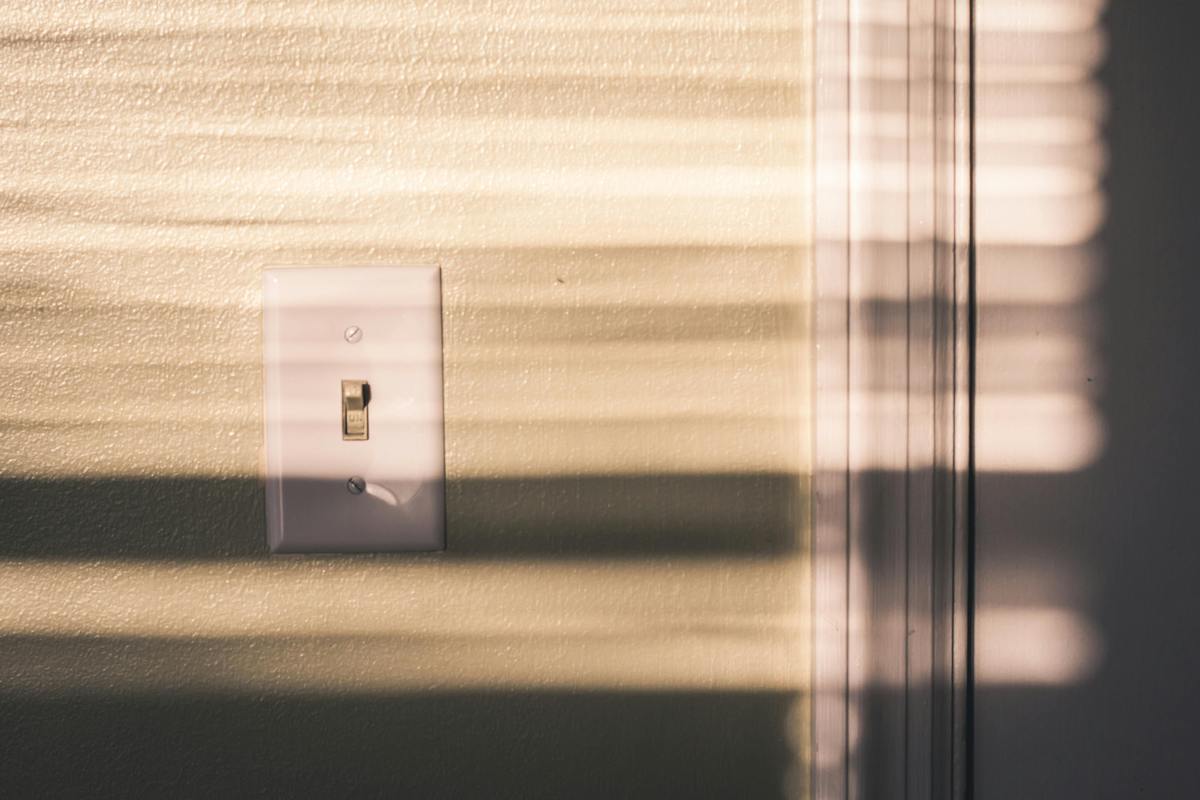
The humble light switch is on the receiving end of the entire infrastructure of the electrical grid.
The final destination of all the power generated and sent to the grid is the homes and businesses of electricity consumers. Any object that consumes electricity is called a “load,” and serving loads is the object of the distribution utilities, which are also called “load-serving entities” (this will be important later on).
In the past, serving loads was a fairly straightforward job, but times are changing. Many homes and businesses now have DERs like solar panel installations and batteries. And still more consumers have internet-connected devices like smart thermostats, water heaters, EV chargers, and more.
Because of these recent developments in connected home appliances and distributed energy, modern consumers have more of an opportunity to participate in the grid than ever before. Utilities in many states have initiated voluntary demand response programs, under which they do things like remotely adjust smart thermostats, reserve water heating and EV charging for non-peak times, or even activate their customers’ home battery storage when the grid needs extra power.
Of course, millions of people still simply use electricity when they need it, turning on lights and appliances, acting simply as users of power. But the grid of the future will see energy consumers, producers, and grid operators become more interdependent and interactive. That transition is prompting a new flurry of regulations to maintain order and steer the future development of grid-supporting technologies.
Structure, regulation, and power management on the grid
When taken together, generation, transmission, and distribution are called the supply chain. In the United States, entities called utility companies are tasked with the job of operating the supply chain in the public interest. There are generally three types of utility companies:
Public utilities, also called municipal utilities, which are owned by the local governments of the communities they serve
Co-operative utilities, which are collectively owned by their customers and operated by an elected board of directors and leadership
Investor-owned utilities, which operate for the profit of their shareholders and can be publicly traded or privately held
Service territories
There are many different ways to structure a utility. Most states have regulated electricity markets. In these places, customers have no choice over who they buy electricity from and are mostly served by “vertically integrated” utilities that produce, transmit, and distribute power. These utilities must offer service to all customers inside a defined service territory.
Other states have a deregulated energy market, in which various different entities operate separate parts of the grid. Consumers in these markets often have the ability to choose who they buy power from, although the distribution is still handled by the utility that operates the wires. These are known as “wires-only” utilities because they transmit and/or deliver electricity purchased from other sources.
Finally, municipal and co-op utilities operate even in states with regulated energy markets, especially in lesser-populated areas. And even in regulated markets, energy can be sold between neighboring utilities when necessary. It gets quite complicated, especially when power is transmitted across state lines. That complexity requires some serious oversight.
Who oversees the grid?
Utilities are overseen by several federal and state agencies as well as some industry and non-profit groups that are given authority to oversee the grid by the government. Here’s a quick rundown:
The Federal Energy Regulatory Commission (FERC) is a U.S. government agency that oversees the interstate sale and transmission of electricity and natural gas and the operation of oil pipelines and hydropower plants for the entire country. FERC commissioners make the rules that govern how utilities can operate.
Regional Transmission Organizations (RTOs) and Independent System Operators (ISOs) are responsible for managing the transmission infrastructure in their geographic region and operating wholesale energy markets. They do not own any physical assets like transmission lines but instead ensure that the grid works efficiently by managing congestion, facilitating the marketplace, and coordinating the planning of grid expansions based on expected future needs.
The North American Electric Reliability Corporation (NERC) is an industry non-profit with authority (granted by congress) to act as the nation’s Energy Reliability Organization (ERO). NERC ensures that the bulk energy system is resilient and reliable and oversees six smaller regional reliability organizations (see map below).
State public utility commissions set rules for how for-profit utilities can operate within a state. They are responsible for approving the utilities’ capital expenditures and rate filings, and for carrying out laws passed by state legislatures that require utilities to act in a certain way (for example, Renewable Portfolio Standards).
How the grid is divided up
Zooming out to the 10,000-foot view, the North American electric grid covers the lower 48 states and much of Canada. The grid is actually made up of three smaller grids that cover large geographical regions and mostly operate independently from one another. The first two are the Eastern and Western Interconnections, which are divided by the Rocky Mountains. The third is the Texas Interconnection, which covers most of the Lone Star State. There are just a few places where wires pass between these interconnections.

The three interconnections of the U.S. grid. Image source: publicpower.org
Within the interconnections, the six regional reliability organizations oversee various areas:
The Western Interconnection is managed by the Western Electricity Coordinating Council (WECC)
The Eastern Interconnection is divided into segments controlled by the Midwest Reliability Organization (MRO), the SERC Reliability Corporation (SERC), ReliabilityFirst (RF), and the Northeast Power Coordinating Council (NPCC)
The Texas Interconnection is managed by the Texas Reliability Entity (Texas RE)
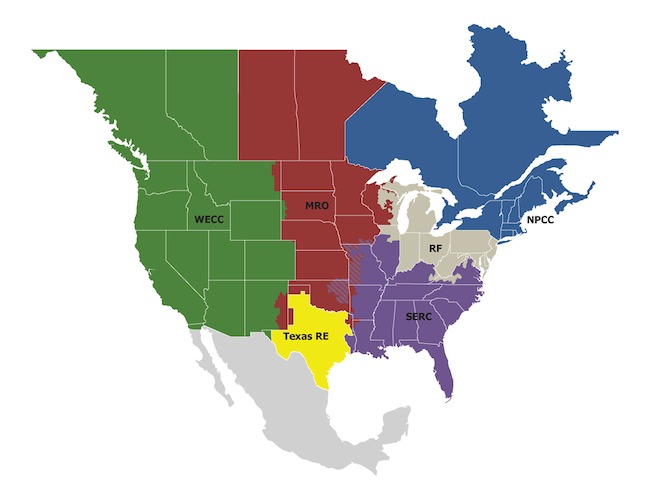
A territory map showing the six regional reliability organizations. Image source: NERC
NERC authorizes these reliability organizations to oversee grid operation to make sure that the power supply will remain stable for all consumers. That’s a very big job, and reliability organizations can only do it with help.
Balancing the grid
As we said at the start, the U.S. electric grid is the world's largest and most complicated machine. It’s a machine that has to have a precise balance between the amount of power generated and the amount used at any given time.
That complexity and the need for accuracy requires constant supervision, which is primarily the responsibility of balancing authorities. These entities operate under the regional reliability organizations to ensure that the generation and load are matched evenly across the geographical area they control.
Balancing authorities are mostly individual utilities that are responsible for monitoring the supply and demand of power in real-time and reacting within seconds to correct any imbalances. For example, balancing authorities can ramp up or down production at local generation plants or procure emergency power from another nearby balancing authority’s territory.
Energy markets
Energy markets are operated across geographic regions so owners of generation, transmission, and distribution infrastructure can buy and sell their services across state lines to make sure that power is available when and where it is needed.
For electricity to get from a generator to customers, it must first be purchased by the distribution utility (i.e. load-serving entity) and booked for transmission across a high-voltage power line. Most energy is purchased by load-serving entities from generators through set contracts. Energy use that varies day by day is purchased in an open auction on an energy market.
The amount of energy needed in a given day depends on predictions made by load-serving entities of what their customers’ power needs will be at any given time. Most market transactions happen on a day-ahead basis, with utilities basing their predicted needs on historical usage and expected weather conditions. Additional transactions are made in the real-time market, once every hour and once every five minutes, to ensure supply exactly matches demand.
Market operators
As mentioned above, energy markets in the U.S. are mostly overseen by RTOs and ISOs, but in certain areas—the northwest, southwest, and southeast areas—markets are operated by individual utility companies or federal agencies like the Tennessee Valley Authority. Here’s a map that shows the various market operators and areas:
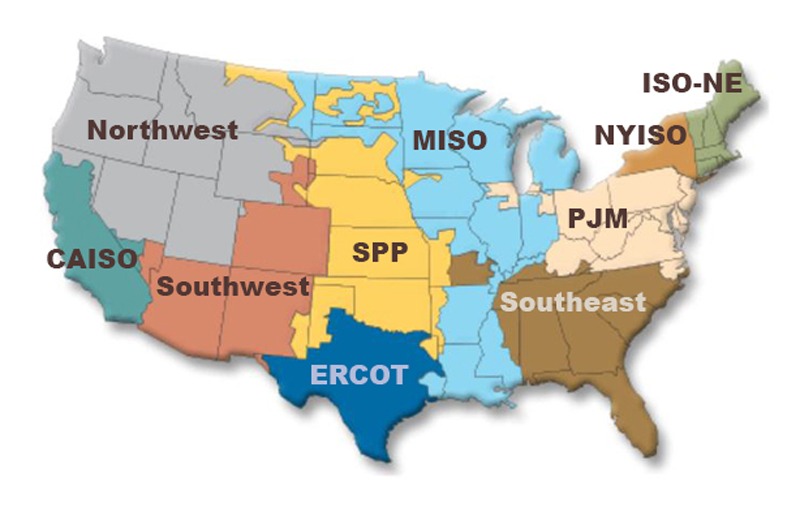
A map showing the various Power Markets in the U.S. Image source: FERC
FERC tasks energy market operators with running the centralized auctions that determine the prices of the day-ahead and real-time transactions described above. They must also ensure that every entity working on the grid has open access to real-time market information they can use to decide how to buy and sell services. RTOs and ISOs are responsible for ensuring that the market functions efficiently and for planning future upgrades and expansions of the transmission grid to provide for the continued efficiency of the marketplace.
Putting it all together: how the grid works
Nearly every day in America, the grid operates so smoothly that most of us hardly even think about it. Turn on a light switch, plug in your smartphone, or start the clothes dryer; it just works. But every time you turn on an appliance, that power has to come from a generator somewhere. In a way, operators of the grid knew you were going to do that and had the power available at just the right moment.
There are thousands of workers whose job is to keep it that way. For example, generation plant workers bid their power into the wholesale markets, while workers at load-serving entities place orders for day-ahead power, then keep an eye on the demand from their customers and adjust their orders on an hourly basis and every five minutes. Of course, most of this work is handled using computers with models based on petabytes of data about weather patterns, historical usage, and expected peaks.
Workers at balancing authorities ensure that any changes in usage are addressed by spinning up peaker plants, activating responsive loads, or curtailing excess generation. Workers at RTOs ensure that capacity on the grid is available and reliable to carry the electricity from the generator, across the transmission system, to the distribution substations that send out power to customers.
What happens when demand exceeds supply?
In extreme weather and other unforeseen circumstances, the grid can experience short-term spikes in demand. Similarly, if a large source of electricity generation fails, peaker plants need to be quickly activated to make up for the difference in supply.
These spikes are handled mainly by the market, with energy from peaking sources becoming extremely expensive during periods of high demand or supply disruption. If demand exceeds supply, the frequency of electricity on the grid can drop below operating parameters. To correct the problem, the utility might engage in load shedding, which means turning off parts of the grid to reduce demand. This can take the form of targeted or rolling blackouts.
Thankfully, these events are becoming more manageable than in years past, and there are new tools entities on the grid can use to respond. Demand response is one of the most important tools, in which utilities can literally match demand to supply by controlling their customer’s usage of electricity. This is accomplished by adjusting smart thermostats and appliances and activating customers’ batteries, among other things.
Most of the time, demand response events can be predicted a day (or at least a few hours) in advance; when very high temperatures are forecasted, for example. Customers who have voluntarily joined a demand response program get a notification that the utility will remotely control their thermostat or battery, and oftentimes have the ability to opt-out of that control.
However, that’s not always the case. In one recent notable event, Colorado utility Xcel Energy took control of the smart thermostats of 22,000 customers without notice when a 1,635 MW coal-fired power plant unexpectedly went offline during a heatwave. Those customers had their thermostats locked at 78 or 79 degrees but likely prevented a targeted blackout that could have caused thousands of people to lose power in the sweltering heat.
The future of the grid
Decarbonization, demand response, and distributed energy resources. These things are the future of the grid, but they’ve started making a big difference in the present, too.
We need to decarbonize the electric grid to fight climate change. Thankfully, decarbonization is becoming the right financial decision, as well. As we discussed above, legacy fossil fuel plants that require ongoing supplies of dirty feedstock are very much the old way of doing things.
With zero fuel cost and minimal operation and maintenance needs, large-scale solar provides stability in future energy prices. That’s far superior to fossil fuels, which frequently change in cost due to a number of factors, including war, trade disputes, and other geopolitical problems. In many cases, building new solar capacity is already less expensive than operating existing coal plants and building new natural gas facilities.
Of course, the intermittency of solar and wind means there will need to be strategies to deal with large amounts of “extra” renewable energy. Doing that will likely require upgrades to both transmission infrastructure and energy storage, which will add to costs.
Thankfully, funding for those upgrades already exists in the Infrastructure Investment and Jobs Act and the Inflation Reduction Act. Programs outlined in those bills promote battery storage and new transmission infrastructure to help the grid integrate more renewables and make it easier for grid operators to respond to emergency events.
Speaking of batteries in homes, they’re distributed energy resources (DERs) just like rooftop solar panels. These devices are great for homeowners because they provide backup power in case of an outage and help people reduce their energy bills in states with net metering.
But the future holds a different path for DERs, because of FERC Order 2222, which will allow DERs to participate in wholesale energy markets when its design is finalized. This doesn’t mean individual battery owners will be bidding generation capacity into RTO auctions. Instead, groups of DERs, sometimes called “virtual power plants” (VPPs), will be operated remotely by aggregators, and DER owners will receive some of the monetary benefits of the services the VPP supplies to the market. This is already happening in California, where sonnen operates a VPP selling capacity to CAISO and earning their customers money every month, and Tesla customers can earn compensation by joining a VPP to support the PG&E grid.
Although current solar and battery solutions can help provide you with power in a grid outage, they don’t help your neighbors much (yet). With smart electrical panels and appliances, solar panels, and connected home batteries, the future of the grid will be more interdependent and automated than ever before, allowing every circuit in your home to participate in ensuring grid reliability for everyone.
Conclusion
The electric grid has come a long way from Pearl Street Station, growing from under 100 customers to serving millions of Americans and Canadians with reliable electricity for their homes and businesses. The future of the grid will include many more independently-owned resources that create clean power from the sun, wind, and water, working together to contribute to the stability and environmental quality of the nation.
This article merely scratched the surface of how the grid works. If you want to learn more, check out these resources that provide a much more in-depth look at how the most complex machine known to humanity operates:
A Primer on Electric Utilities, Deregulation, and Restructuring of U.S. Electricity Markets (pdf)
Renewables 101: Integrating Renewable Energy Resources into the Grid (and click through to other articles in their Future of Power Explainer Series)
Ben Zientara is a writer, researcher, and solar policy analyst who has written about the residential solar industry, the electric grid, and state utility policy since 2013. His early work included leading the team that produced the annual State Solar Power Rankings Report for the Solar Power Rocks website from 2015 to 2020. The rankings were utilized and referenced by a diverse mix of policymakers, advocacy groups, and media including The Center...
Learn more about Ben Zientara